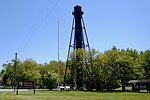Finns Point Range Light
1877 establishments in New JerseyLighthouses completed in 1877Lighthouses on the National Register of Historic Places in New JerseyNational Register of Historic Places in Salem County, New JerseyTransportation buildings and structures in Salem County, New Jersey ... and 1 more
United States lighthouse stubs

The Finns Point Range Rear Light is a lighthouse in Pennsville Township, Salem County, New Jersey. It is located just east of the Delaware River and was part of Range light pair that guided ships into the Delaware River. It is deactivated, and its lamp and lens have been removed, but the lighthouse is open to the public as part of a National Wildlife Refuge. It was designed and built in 1877 and is a classic example of a skeletal cast iron prefabricated lighthouse. Its companion Front range light was demolished and replaced with an offshore automated light in 1938. Both the Rear and replacement Front lights were deactivated in 1950.
Excerpt from the Wikipedia article Finns Point Range Light (License: CC BY-SA 3.0, Authors, Images).Finns Point Range Light
Old Fort Mott Road,
Geographical coordinates (GPS) Address Nearby Places Show on map
Geographical coordinates (GPS)
| Latitude | Longitude |
|---|---|
| N 39.617222222222 ° | E -75.534166666667 ° |
Address
Old Fort Mott Road 300
08070
New Jersey, United States
Open on Google Maps





